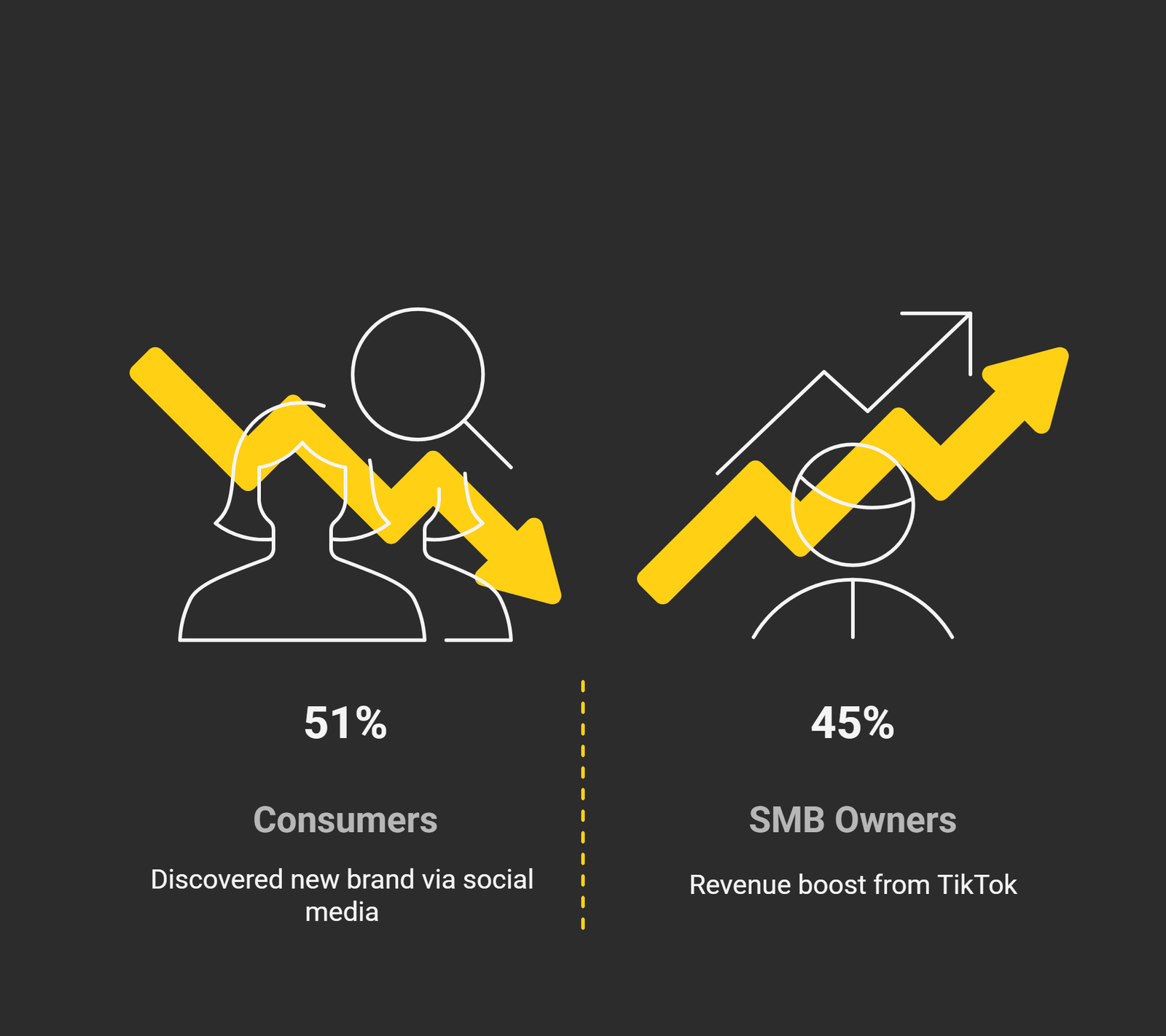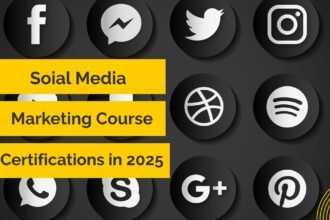I’ve watched firsthand how social media marketing for small business has moved from optional extra to essential growth engine. In 2025, over 5.41 billion people—around 65.7% of the global population—are using social media regularly. That’s nearly two-thirds of humanity scrolling, sharing, and shopping online. On average, users spend over 2 hours and 20 minutes each day across nearly 7 platforms.
When I advise business owners, I emphasize that social media marketing for small business isn’t about posting for its own sake. It’s about creating targeted, meaningful content that builds trust, grows engagement, and directs prospects to your digital front door. Whether it’s a video, a story, or a live stream, each format supports brand awareness, customer engagement, and long-term relationships.
In this publication, I’ll show you how to use platforms like Instagram, TikTok, Facebook, LinkedIn, and YouTube strategically. We’ll explore content calendars, platform selection, paid vs. organic marketing, tools for analytics, and real-world trends that deliver ROI—all while you stay agile, trend-aware, and data-driven.
Why Social Media Marketing for Small Business is Essential
From my experience working with founders, marketing executives, and small business owners, I can say with certainty: social media marketing for small business is one of the most cost-effective growth channels available today. Unlike traditional advertising, where a single print ad or radio spot can eat up a month’s marketing budget, social media gives you precision targeting, real-time feedback, and the ability to reach thousands—sometimes millions—without massive upfront costs.
The data is undeniable. According to Hootsuite’s 2025 Digital Trends report, 51% of global consumers say they’ve discovered a new brand through social media in the last year. TikTok alone has become a growth driver for small brands, with 45% of SMB owners crediting it for a noticeable revenue boost. Platforms like Facebook and Instagram continue to deliver strong returns, especially when paired with localized targeting and community engagement strategies.

For a small business, social media is more than a sales channel—it’s a brand trust builder. Consistent posting of relevant, high-quality content establishes credibility. Quick responses to comments and messages show customers that you value their time. Sharing behind-the-scenes content or customer stories creates a sense of authenticity that today’s audiences demand.
Another key advantage is the measurable ROI. With built-in analytics, you can see exactly which campaigns drive engagement, website traffic, and sales. That means no guesswork—you can refine your strategy based on hard numbers, not hunches.
In short, social media marketing for small business is no longer a “nice-to-have.” It’s a primary driver for brand awareness, customer acquisition, and retention. The businesses that win in 2025 will be the ones that leverage social media not just to promote, but to connect, listen, and adapt in real time.
5 Core Pillars of a Winning Social Media Marketing Strategy
Over the years, I’ve found that the difference between hit-or-miss posting and consistent results in social media marketing for small business comes down to five core pillars. When these work together, they turn social channels into predictable growth engines.
- Strategy
Everything starts with a plan. You need to define your goals—whether that’s driving website traffic, boosting sales, building brand awareness, or improving customer engagement. A strategy aligns your message, platforms, and posting schedule with those objectives. - Content Creation
Your posts are the voice of your brand. High-quality visuals, clear messaging, and storytelling that resonates with your target audience make the difference. Mixing content formats—short-form videos, carousel posts, live sessions—keeps your audience engaged and your brand top of mind. - Community Engagement
Social media isn’t a broadcast tool; it’s a conversation space. Responding to comments, joining discussions, and encouraging user-generated content builds loyalty. People want to feel heard, and engagement is how you show them you care. - Advertising
Paid campaigns amplify reach and accelerate growth. Even a modest ad budget can produce results if you target the right audience and optimize your creatives. Ads help you scale what’s already working organically. - Analytics
Without data, you’re guessing. Every platform offers analytics tools—use them. Track metrics like engagement rate, click-through rate, and conversions to identify what works and refine your approach.
When you integrate these pillars into your daily operations, social media marketing for small business shifts from “something we post when we have time” to a measurable, ROI-driven activity. It’s this structured approach that allows small businesses to compete with larger brands on the same platforms.
How to Build a Social Media Marketing Plan for Small Business
When I develop social media marketing for small business strategies, I never start by asking, “What should we post?” Instead, I ask, “What do we want this to achieve?” That’s because an effective plan is less about random creativity and more about structured, goal-driven execution.
- Identify Your Target Audience
The first step is understanding exactly who you want to reach. Go beyond broad demographics—dig into psychographics like interests, challenges, and buying behavior. Tools like Facebook Audience Insights or Google Analytics can help you refine your audience profile. - Conduct a Competitor Analysis
Look at other businesses in your niche. What platforms are they using? Which posts get the most engagement? This isn’t about copying—it’s about spotting content gaps and opportunities to differentiate your brand. - Choose the Right Platforms
Not every social network will be a fit for your business. A café might thrive on Instagram and TikTok, while a consulting firm might get better ROI from LinkedIn. Focus your efforts where your target audience spends the most time. - Set SMART Goals and KPIs
Specific, Measurable, Achievable, Relevant, and Time-bound goals keep your plan focused. For example: “Increase Instagram engagement by 20% in the next 90 days” or “Generate 200 website visits per month from LinkedIn.” - Build a Content Calendar
A content calendar ensures consistency and helps you plan seasonal promotions, product launches, or campaign series. Include post formats, captions, hashtags, and posting times. This is where brand voice and visual identity should stay consistent. - Decide on Organic vs. Paid Mix
Organic posting builds trust over time, while paid ads can accelerate visibility. Even a small ad budget, targeted correctly, can put your business in front of the right people faster. - Monitor and Adjust
Your plan is a living document. Use analytics to measure performance, then adjust based on the data. If video posts are outperforming static images, adapt your content mix accordingly.
When executed with discipline, a well-structured plan transforms social media marketing for small business from an ad-hoc task into a reliable, results-driven system. It allows you to maximize time, budget, and effort—critical for small businesses working with limited resources.
Choosing the Right Social Media Platforms
One of the most common mistakes I see in social media marketing for small business is trying to be everywhere at once. The truth is, not every platform will be right for your brand—or your audience. Your time and budget are better spent focusing on the platforms that deliver the highest return for your goals. Let’s break down the major players and where they fit.
Facebook – The Local Business Hub
With over 3 billion monthly active users, Facebook remains a powerhouse for small business marketing. Its advanced targeting lets you reach people by location, interests, and behavior, making it ideal for local customer acquisition. Features like Facebook Groups, Events, and Marketplace can help build community and drive in-person or online sales.
Instagram – Visual Storytelling at Scale
Instagram is perfect for brands that can showcase their products or services visually—think cafés, boutiques, salons, and lifestyle brands. Short-form video via Reels is dominating engagement right now, while Stories allow for quick, informal updates. Instagram Shopping makes it possible for customers to buy without leaving the app.
LinkedIn – B2B and Professional Authority
For service providers, consultants, and B2B companies, LinkedIn is where decision-makers spend their time. It’s the best place to share thought leadership, case studies, and industry insights. Paid ads on LinkedIn are more expensive than other platforms, but they often deliver highly qualified leads.
TikTok – Viral Reach and Cultural Relevance
TikTok’s algorithm is designed to surface engaging content from anyone—not just big brands. This levels the playing field for small businesses. Creative, authentic short videos can rack up thousands (or even millions) of views quickly. Trends change fast here, so agility is key.
YouTube – Long-Form Value Content
YouTube is the second-largest search engine in the world. It’s ideal for tutorials, product reviews, and behind-the-scenes content that establishes expertise. YouTube content also has a long shelf life compared to other platforms, meaning a single high-quality video can generate traffic for years.
Pinterest – The Discovery Engine
Pinterest works best for industries like home décor, fashion, events, and DIY. Users often come here with buying intent, searching for inspiration before making a purchase. Pins can drive consistent website traffic for months after posting, making it a strong option for evergreen content.
How to Choose Your Platforms
When deciding where to focus:
- Know Your Audience – Match platform demographics to your target market.
- Assess Your Content Strengths – If you’re great with video, prioritize TikTok, Instagram, or YouTube. If your brand thrives on educational content, consider LinkedIn or YouTube.
- Start with One or Two – It’s better to dominate a couple of platforms than spread yourself too thin.
- Test and Measure – Use analytics to see where your efforts are paying off and adjust your focus accordingly.
The best social media marketing for small business strategies are not about chasing every trend, but about aligning platform strengths with your brand’s voice, audience habits, and growth objectives. By being selective and intentional, you can build a strong presence that actually drives revenue—without burning out your team or draining your budget.
Content Strategy for Small Business Social Media Marketing
In my experience, the content strategy is where social media marketing for small business truly comes to life. Even the most advanced analytics and advertising tools won’t deliver results if your content doesn’t connect with your audience. The goal is to create posts that are not just seen, but remembered—and acted upon.
Types of Content to Include
A strong content strategy uses variety to keep audiences engaged:
- Short-Form Video: Platforms like TikTok and Instagram Reels reward quick, engaging clips that capture attention in the first few seconds.
- Carousel Posts: Perfect for educational tips, product features, or step-by-step tutorials.
- Stories and Live Streams: These create a sense of urgency and allow for real-time interaction.
- User-Generated Content (UGC): Sharing photos, reviews, or testimonials from customers builds trust and authenticity.
- Behind-the-Scenes: Show the human side of your business—your team, your process, or your workspace.
Creating a Content Calendar
Consistency is the secret weapon in social media marketing for small business. A content calendar helps you plan ahead, balance different content formats, and ensure you’re posting regularly without scrambling for ideas. I recommend mapping out at least two weeks in advance, with room for spontaneous, trend-based posts.
Maintaining Brand Consistency
Your tone of voice, visual style, and messaging should be consistent across all platforms. This builds recognition and trust. Use brand colors, consistent fonts, and a clear message in every piece of content.
Repurposing Content
One of the most efficient tactics is repurposing. A blog post can be turned into multiple Instagram carousels, a short video, and a LinkedIn article. This extends the life of your content and ensures it reaches audiences in different formats.
Balancing Organic and Promotional Posts
If every post is a sales pitch, followers will tune out. I follow an 80/20 approach—80% valuable, educational, or entertaining content, and 20% direct promotion. This keeps audiences engaged while still moving them toward a purchase.
When done right, content strategy transforms social media marketing for small business from sporadic posting into a deliberate, results-driven process. It ensures every piece of content works toward your business goals, whether that’s generating leads, building community, or increasing sales.
Engagement & Community Building
One of the most overlooked elements of social media marketing for small business is engagement. Too many brands focus solely on posting content, forgetting that social media is meant to be a two-way conversation. If you’re not actively interacting with your audience, you’re missing one of the biggest opportunities for growth and loyalty.
Responding to Comments and Messages
I make it a rule to respond to every genuine comment and direct message. This isn’t just about being polite—it signals to the algorithm that your content is valuable, and it tells your audience you care about their input. A quick reply can turn a casual follower into a loyal customer.
Hosting Interactive Sessions
Features like Q&A sessions, live streams, polls, and Instagram Story quizzes are powerful engagement tools. They invite participation, spark discussions, and make your followers feel like part of the brand’s journey.
Encouraging User-Generated Content
UGC is one of the strongest trust-builders in social media marketing for small business. Ask customers to share photos using your product or tag you in their stories. Not only does this provide you with authentic content, but it also strengthens your relationship with your customers.
Creating a Sense of Community
A true community is built when your audience connects not just with you, but with each other. This can happen in a Facebook Group, a recurring live show, or even through comment threads. Recognizing loyal followers publicly and highlighting their contributions can make them feel valued and seen.
Engagement is what transforms followers into advocates. When people feel heard, valued, and connected, they’re far more likely to recommend your business to others—and that kind of word-of-mouth marketing is priceless.
Paid Social Media Advertising for Small Business
While organic reach is valuable, there comes a point in social media marketing for small business where paid advertising can accelerate growth far beyond what consistent posting alone can achieve. The beauty of paid social is its ability to place your message directly in front of highly targeted audiences—whether that’s people in your local area, specific age groups, or those with demonstrated interest in your products or services.
When to Start Paid Ads
I usually recommend small businesses test paid campaigns once they’ve established a steady organic presence and identified content types that perform well. Ads work best when they amplify what’s already engaging your audience.
Budgeting for Ads
Contrary to the belief that advertising is only for large corporations, many small businesses see great returns with budgets as low as $5–$20 per day. The key is precise targeting and ongoing optimization. Start small, track performance, and scale what works.
Targeting and Retargeting
Platforms like Facebook, Instagram, and LinkedIn offer robust targeting options. You can segment by demographics, location, behaviors, and even retarget people who have visited your website or engaged with your content. Retargeting ads, in particular, often yield the highest ROI because they reach warm leads who already know your brand.
Measuring ROI
Each paid campaign should have a clear objective—such as website clicks, leads, or direct sales. Use built-in analytics and conversion tracking tools to measure outcomes. If a campaign isn’t delivering, adjust your targeting, creatives, or ad copy rather than abandoning paid ads altogether.
When approached strategically, paid campaigns can transform social media marketing for small business from a slow climb into a fast track for brand awareness, lead generation, and sales growth.
Analytics & Performance Optimization
In my experience, one of the defining traits of successful social media marketing for small business is a commitment to data-driven decision-making. Without analytics, you’re essentially guessing which strategies are working and which are wasting time and money.
Tracking the Right Metrics
Each platform provides built-in analytics, but the key is knowing which metrics to prioritize. For most small businesses, I focus on:
- Engagement Rate – Measures how actively your audience interacts with your content.
- Reach and Impressions – Indicates how many people are seeing your posts.
- Click-Through Rate (CTR) – Shows how effective your call-to-actions are.
- Conversions – Tracks how many leads or sales result from your social media efforts.
Using Social Listening
Beyond hard metrics, social listening tools like Hootsuite Streams or Brandwatch help track brand mentions, customer sentiment, and trending topics. This gives you valuable insights into how your audience perceives your business and what content resonates most.
A/B Testing
Optimization often comes down to experimentation. I regularly run A/B tests on ad creatives, captions, hashtags, and posting times. Small tweaks—like changing a headline or switching a thumbnail—can yield significant performance improvements.
Review and Refine
Analytics should inform your next steps. If video posts are outperforming static images, shift more resources to video production. If your engagement drops, revisit your content mix and posting schedule.
When you integrate analytics and optimization into your routine, social media marketing for small business becomes a living, evolving strategy. Every decision is backed by real data, ensuring you maximize both your reach and your return on investment.
Social Media Marketing Trends for Small Business in 2025
Keeping up with trends is essential if you want social media marketing for small business to remain competitive. Platforms evolve quickly, algorithms change, and audience expectations shift. In 2025, several trends stand out as game-changers for small business owners.
1. Short-Form Video Dominance
TikTok, Instagram Reels, and YouTube Shorts continue to dominate engagement. Audiences respond to quick, visually engaging content that delivers value in under 30 seconds. Small businesses are leveraging these formats for product demos, tips, and behind-the-scenes clips.
2. Micro-Influencer Partnerships
Rather than chasing celebrity endorsements, small businesses are working with micro-influencers—creators with 1,000–50,000 highly engaged followers. These partnerships are cost-effective and often produce better engagement rates than larger influencers.
3. AI-Powered Content Tools
Artificial intelligence is streamlining content creation, scheduling, and analytics. From auto-generating captions to suggesting optimal posting times, AI tools allow small businesses to save time while improving quality.
4. Social Commerce Expansion
Shopping directly within social media platforms is growing rapidly. Features like Instagram Shops, TikTok Shop, and Facebook Marketplace make it easier than ever to turn followers into customers without them leaving the app.
5. Values-Driven Branding
Consumers increasingly want to support brands that align with their values. Small businesses that share their sustainability efforts, community involvement, or ethical sourcing gain deeper customer loyalty.
Staying on top of these trends doesn’t mean chasing every new feature. Instead, it’s about strategically adopting the ones that align with your goals and audience. The most successful social media marketing for small business campaigns in 2025 will be agile, authentic, and data-informed.
Best Tools for Social Media Marketing for Small Business
One thing I’ve learned after managing countless campaigns is that the right tools can make social media marketing for small business far more efficient and effective. You don’t need to invest in expensive enterprise software—many budget-friendly (and even free) tools deliver excellent results.
Content Creation
- Canva – Ideal for creating professional graphics, carousels, and short videos without design experience.
- Flexclip – Perfect suit for AI videos, Text to Speech, AI Script Generation and lots more.
- CapCut – Perfect for editing TikTok and Reels videos with trendy effects and transitions.
Scheduling and Automation
- Buffer or Later – Let you plan and schedule posts across multiple platforms, ensuring consistent posting even during busy weeks.
- Meta Business Suite – A free option for managing Facebook and Instagram content, messages, and ads.
Analytics and Tracking
- Hootsuite – Offers detailed performance reports and social listening features.
- Google Analytics – Tracks how social media traffic converts once visitors land on your website.
By using the right combination of creation, scheduling, and analytics tools, small businesses can streamline their workflow, maintain brand consistency, and make data-driven decisions. The right tech stack can save hours each week while improving the results of your social media marketing for small business campaigns.
90-Day Action Plan for Small Business Social Media Growth
A well-structured action plan turns social media marketing for small business from a vague goal into a measurable, achievable process. Here’s a roadmap I recommend for the first 90 days.
Month 1 – Foundation & Strategy
- Define your target audience and key platforms.
- Set SMART goals (e.g., “Gain 500 Instagram followers in 90 days”).
- Build a basic content calendar.
- Create brand guidelines for tone, visuals, and messaging.
Month 2 – Content & Engagement
- Post consistently, at least 3–5 times per week per platform.
- Test different content formats (video, carousel, stories, live streams).
- Engage daily: reply to comments, answer messages, and participate in relevant community discussions.
- Begin small-scale ad testing to boost high-performing posts.
Month 3 – Optimization & Scaling
- Review analytics to see what’s working.
- Double down on high-engagement content types.
- Increase ad spend for top-performing campaigns.
- Introduce influencer partnerships or collaborations.
By following this structure, you’ll establish a solid presence, identify what resonates with your audience, and set the stage for long-term growth. In social media marketing for small business, consistency plus data-driven decisions is the formula for sustainable success.
Conclusion
Over the past decade, I’ve seen social media marketing for small business evolve from an optional add-on to a core driver of growth. In 2025, it’s one of the most powerful, cost-effective ways to build brand awareness, attract new customers, and strengthen relationships with existing ones. The strategies we’ve covered—from choosing the right platforms and building a content calendar to running targeted ads and analyzing performance—are not theory; they’re proven, actionable steps that work when applied consistently.
The key takeaway is this: success comes from clarity and commitment. Focus on the platforms that matter most to your audience, create valuable content, engage authentically, and make data-driven decisions. Small businesses don’t need massive budgets to compete—they need smart, intentional strategies.
Now it’s your turn. Start implementing this guide today. Whether you begin with a 90-day action plan, experiment with short-form video, or test your first ad campaign, the important thing is to take action and adjust as you learn.
Frequently Asked Questions on Social Media Marketing for Small Business
What is the most effective social media platform for small business?
It depends on your audience and goals. Instagram and TikTok excel for visually driven brands, especially in retail, beauty, and lifestyle niches. LinkedIn is ideal for B2B companies, consultants, and service providers. Facebook remains strong for local targeting and community building, while YouTube is best for long-form educational content.
How much should a small business spend on social media marketing?
For most small businesses, I recommend allocating 5–10% of revenue to marketing, with 30–50% of that budget dedicated to social media marketing for small business. Start with a small ad spend—$5–$20 per day—on platforms where you’ve already seen organic engagement.
How often should I post?
Consistency is more important than frequency. Most small businesses see good results posting 3–5 times per week per platform, with daily engagement through comments, DMs, and stories.
Can social media marketing work without paid ads?
Yes. Many small businesses achieve growth through organic reach by creating valuable, shareable content and engaging with their audience. However, paid ads can accelerate visibility and reach.
How do I measure success?
Track metrics like engagement rate, follower growth, website traffic from social media, and sales conversions. Use platform analytics along with Google Analytics to see how social media visitors behave on your website.
Is influencer marketing worth it for small business?
Yes—especially with micro-influencers (1,000–50,000 followers). They often have higher engagement rates and charge less than large influencers, making them ideal for small business budgets.
How long does it take to see results from social media marketing?
Organic strategies typically take 3–6 months to show consistent results. Paid campaigns can produce measurable outcomes within weeks, especially if your targeting and creatives are strong.
Should I be on every social media platform?
No. It’s better to master one or two platforms that align with your audience and content style than to spread yourself thin across too many.
What kind of content performs best?
In 2025, short-form videos, user-generated content, behind-the-scenes posts, and educational carousel posts are driving the most engagement. Test multiple formats to see what resonates with your audience.
Do I need a content calendar?
Absolutely. A content calendar keeps you consistent, ensures a balanced mix of content types, and helps you plan ahead for seasonal promotions, launches, and campaigns.








